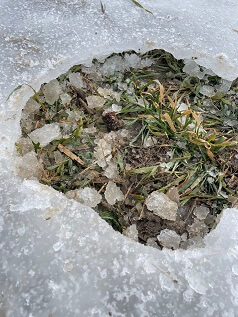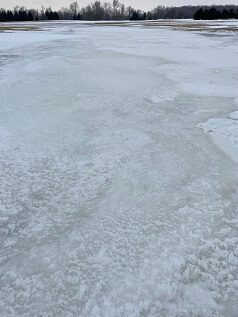Winter wheat is the only row crop grown across three seasons in Ontario. That fact opens it up to a lot of weather risk.
There are some differences between winter wheat varieties and their ability to fight through tough weather conditions, but those differences aren’t dramatic. Environmental conditions, topography, drainage and crop system have a much bigger impact on winter survivability of a winter wheat crop.
The majority of winter wheat acres in Ontario are direct-seeded right behind soybeans or edible beans. If those crops come off well there’s a good chance for the wheat crop to establish itself before winter. Wet, saturated days don’t give the small plants a chance to get established, rooted properly, and grow to a point where they are hardy and durable.
You can have a pretty good idea what a winter wheat crop will look like coming out of the winter by considering the weather the crop had to face through the fall and winter.
A bad year for winter wheat survival was 2019, when one third of the winter wheat acres had to be taken out. It was one of the worst-case scenarios through the winter. A heavy snow pack got rained on mid-winter. The rain turned the snow to slush and the pack settled down into the crop. The winter wheat plants ended up being encased in ice and basically choked of oxygen.
On the other hand, 2021 was perfect in Ontario. The crop went in on time in the fall. It was a good winter with a good snow pack to protect the crop, and it was a nice spring where temperatures warmed consistently. There was a record wheat crop that year in a lot of counties.
If the winter wheat plants in the field don’t get a chance to establish themselves in the fall they will be less able to withstand a difficult spring. The freeze-thaw can act like a lever and raise a small plant with a poor root system out of the ground. The root system can become disconnected from the plant. More mature plants are able to ride out the heaving in the spring.

Hole chopped through 1-2 inches of ice crust suspended 2-3 inches above the ground. Water has drained away; crop will be able to access oxygen when it begins to grow. No issues here.

This crop is at risk. The wet snow turned to slush, then ice. The ice is firm to the ground. Wheat plants are encased in frozen slush. This ice is 4-10 inches thick and will take a long time to melt, and wheat plants will not have access to oxygen.
The first step in assessing a winter wheat stand is to check the seeding depth. Use a shovel to unearth some of the plants and make sure it got seeded to the one-inch mark. Plants established near the soil surface won’t survive.
Next, look at the plant growth stage. A stand with a good number of plants with three to four leaves in the spring will be better off.
Finally, do some stand counts. On average, a stand with 15 plants per foot of row or stronger is a crop at full potential. If there are 10 plants or greater, that crop still has significant potential. Fewer than 10 plants per foot of row and the decision needs to be made based on the uniformity of the crop and how advanced each plant is. Producers might decide to keep a less-than-ideal winter wheat stand if they need straw, to meet forward contracting obligations, or for rotational reasons. If there are fewer than seven plants per foot of row, then it really isn’t worth keeping.
If you’re facing a variable crop, try and estimate how large each area of poor stand is, considering the total area of the field. Estimate the size of thin spots. If you can get into the field early, consider planting spring wheat into the thinner areas of the field so that the crop matures together and can be harvested at the same time. You can also interseed barley. The decision to interseed has to be made by the end of March, otherwise you can hold off on deciding whether to terminate a wheat crop until after the lawn gets cut for the first time.
With later planted wheat that had a short fall growth period, applying a percentage of nitrogen early when conditions are conducive, will promote tillering and help maintain optimal yields. With good top growth on early planted wheat with multiple tillers, a delayed Nitrogen application should be practiced. If the stand established is questionable, contact your local P&H agronomist for an infield evaluation.